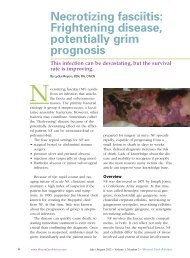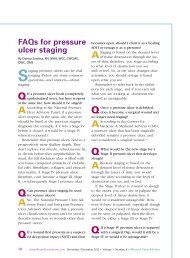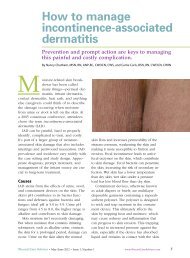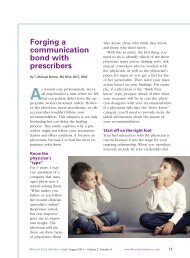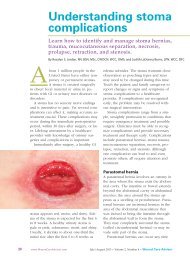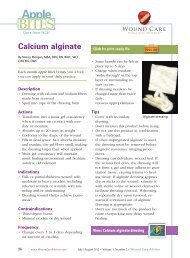PPCO Twist System - Wound Care Advisor
PPCO Twist System - Wound Care Advisor
PPCO Twist System - Wound Care Advisor
Create successful ePaper yourself
Turn your PDF publications into a flip-book with our unique Google optimized e-Paper software.
Interpreting and applying ABI results in CVI patients<br />
The ankle-brachial index (ABI)<br />
can guide clinicians in ordering<br />
safe levels of compression therapy<br />
for CVI patients with or<br />
without associated peripheral<br />
arterial disease.<br />
• ABI of 0.9 or higher, but less<br />
than 1.3: Full therapeutic<br />
compression up to 40 mm<br />
Hg at the ankle can be applied<br />
without concern for<br />
distal ischemia.<br />
• ABI of 0.6 to 0.8: A modified<br />
amount of compression (23<br />
mm Hg or less at the ankle)<br />
should be used. This ABI indicates<br />
clinically compromised<br />
blood flow to the leg,<br />
to the point where the leg<br />
might not tolerate full therapeutic<br />
compression of 40<br />
mm Hg.<br />
• ABI of 0.5 or lower: With this<br />
result, do not apply any compression;<br />
instead, refer the<br />
patient for a vascular consultation.<br />
This ABI means the<br />
compromised leg is getting,<br />
at best, half as much blood<br />
flow as the arm is receiving;<br />
the leg is at significant risk<br />
for ischemia or necrosis, and<br />
might eventually need to be<br />
amputated unless surgical intervention<br />
is successfully performed.<br />
Applying compression<br />
in this case is likely to<br />
increase the risk of ischemic<br />
or necrotic complications.<br />
• ABI of 1.3 or higher: A different<br />
study is needed to guide<br />
the wound care team. This<br />
result most likely is falsely<br />
elevated and can’t be relied<br />
on to determine a safe<br />
amount of compression to<br />
be applied to the leg.<br />
Important: If the patient has<br />
heart failure, compression of<br />
any kind should not be applied<br />
to the extremity regardless of<br />
the ABI value, because the increase<br />
in blood flow leaving the<br />
leg during compression and returning<br />
to a compromised heart<br />
possibly could worsen the heart<br />
failure.<br />
Other indications for obtaining<br />
ABI to assess the arterial tree<br />
of an extremity include:<br />
• a lower extremity with any<br />
wound (wound healing requires<br />
arterial blood flow)<br />
• a weak or absent lowerextremity<br />
pulse (some patients<br />
with PAD may be<br />
asymptomatic)<br />
• a lower-extremity wound<br />
that isn’t healing despite<br />
therapy (clinicians might be<br />
underestimating the extent<br />
of the PAD or that condition<br />
may be worsening).<br />
Ways to do this include elevating the leg,<br />
initiating an exercise program, and using<br />
safe compression therapy. This conservative<br />
approach increases oxygen to the tissues,<br />
decreases edema (improving subcutaneous<br />
swelling, capillary constriction, and<br />
capillary separation), reduces tissue inflammation,<br />
and compresses the dilated veins.<br />
If the patient has changes consistent<br />
with dermatitis or infection, use an appropriate<br />
topical agent—but be aware that<br />
this might preclude the use of long-wearing<br />
compression wraps to allow daily (or<br />
more frequent) access to the extremity for<br />
various medication applications.<br />
If the patient has a noninfected ulcer,<br />
consider using a prolonged wearing wrap<br />
to provide compression, such as a longstretch<br />
system (for example, multilayered<br />
wraps, single-layered wraps, or the Duke<br />
boot). Consider providing a resistance to<br />
leg swelling for ambulatory patients by<br />
using a short-stretch system, such as the<br />
Unna boot. Other options for these patients<br />
include adjustable compression<br />
wraps and intermittent pneumatic compression<br />
devices.<br />
If the patient has an infected ulcer of<br />
the CVI extremity, consider using leg elevation<br />
plus a topical antimicrobial (with or<br />
without systemic antibiotic therapy), and<br />
postpone compression therapy until the infection<br />
is under control.<br />
If the patient has no ulcers or a healed<br />
ulcer (through the proliferative phase of<br />
full-thickness wound healing), use removable<br />
compression stockings or an intermittent<br />
pneumatic pump system.<br />
Ablative therapy<br />
Unfortunately, the patient will need lifelong<br />
compression therapy if CVI can’t be<br />
corrected effectively with other more permanent<br />
forms of therapy. Clinicians might<br />
26 www.<strong>Wound</strong><strong>Care</strong><strong>Advisor</strong>.com May/June 2013 • Volume 2, Number 3 • <strong>Wound</strong> <strong>Care</strong> <strong>Advisor</strong>



